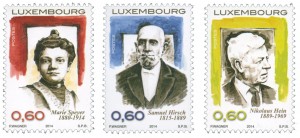Luxembourg issues new stamps on 23 September A series of three stamps is dedicated to two men an one women who have deeply influenced the Luxembourgish society. A series of two stamps on the topic of the importance of the soil consists of the drawings of two young students selected in a nationwide competition. Three stamps showing the flowers of vegetables are the work of an inspired young Luxembourgish artist. The beginning of the First World War is commemorated by a stamp based on an original drawing showing how the German soldiers invaded Luxembourg on 2 August 1914.
“2014 Personalities” series
Marie Speyer (1880-1914) was born in Vianden. At 25, she passed all the compulsory exams to become a primary school teacher. In 1905, she went to study at Fribourg University in Switzerland (it began admitting women in 1865) and presented her doctorate thesis in 1909. In 1911, she was offered the position of assistant director at the Lycée de Jeunes Filles in Luxembourg. She died of cancer at the Saint-François Clinic in Luxembourg, a few days shy of her 34th birthday.
Samuel Hirsch (1809-1889) studied at the universities of Bonn and Berlin, receiving training as a rabbi in Metz. He was a pioneer of liberal Judaism in Germany and a radical voice when the Jewish reform movement was still in its incipience. He was Chief Rabbi of Luxembourg from 1843 to 1866. When, in 1966 Samuel Hirsch was appointed rabbi of the reform community of Philadelphia he immigrated to the USA where he chaired the first North American rabbinical congress in Philadelphia in 1869. He remained rabbi for 22 years in Philadelphia, retiring in 1888 and moving to join his son in Chicago.
Nikolaus Hein (1889-1969) was the son of a winegrower from Ehnen who studied German language and literature, ancient philology and history in Munich (1909-1910) and at the Sorbonne (1910-1912). He taught in Echternach and at the School of Industry and Trade in Luxembourg. Hein dedicated his life to promoting the German language and its literature, composing the “Deutsches Lesebuch für höhere Schulen” (German primer for upper secondary schools) in 1955, which was later revised and updated by Joseph Groben under the title of “Der Brunnen” (The Well). Both the Moselle landscape and the winegrowing profession provided the foundation for his poetry and impressionist prose miniatures.

 Åland
Åland  Faroe Islands
Faroe Islands  Gibraltar
Gibraltar  Greenland
Greenland  Guernsey
Guernsey  Isle of Man
Isle of Man  Jersey
Jersey  Liechtenstein
Liechtenstein  Luxembourg
Luxembourg  Malta
Malta  Monaco
Monaco  Vatican City
Vatican City 
